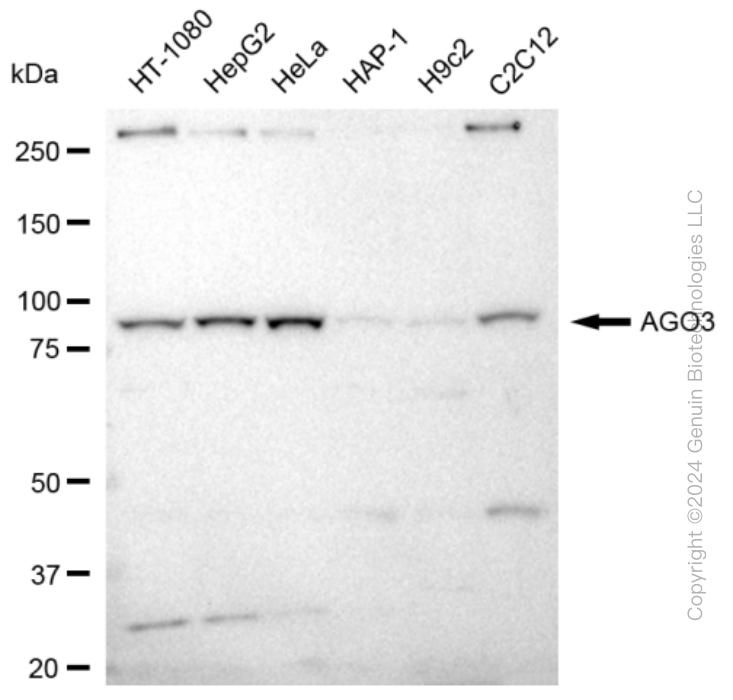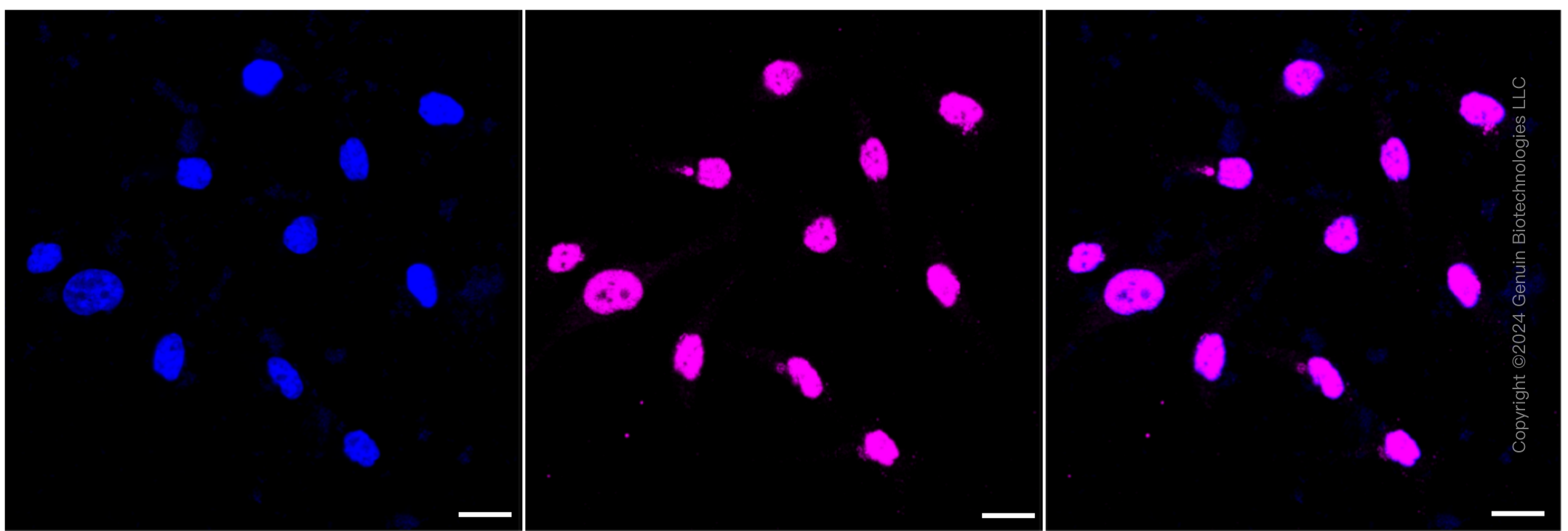KD-Validated Anti-AGO3 Rabbit Monoclonal Antibody
Rabbit monoclonal antibody
- SPECIFICATION
- CITATIONS
- PROTOCOLS
- BACKGROUND

Application
| WB, FC, ICC |
|---|---|
| Primary Accession | Q9H9G7 |
| Reactivity | Human, Mouse |
| Clonality | Monoclonal |
| Isotype | Rabbit IgG |
| Clone Names | 23GB3930 |
| Calculated MW | Predicted, 97 kDa , observed, 97 kDa |
| Gene Name | AGO3 |
| Aliases | AGO3; Argonaute RISC Catalytic Component 3; EIF2C3; Eukaryotic Translation Initiation Factor 2C, 3; Protein Argonaute-3; FLJ12765; HAGO3; HAgo3; Eukaryotic Translation Initiation Factor 2C; Argonaute 3, RISC Catalytic Component; EC 3.1.26.N2; Argonaute 3; Argonaute3; EIF-2C 3; EIF2C 3 |
| Immunogen | A synthesized peptide derived from human EIF2C3 |
| Gene ID | 192669 |
|---|---|
| Other Names | Protein argonaute-3 {ECO:0000255|HAMAP-Rule:MF_03032}, Argonaute3 {ECO:0000255|HAMAP-Rule:MF_03032}, hAgo3, 3.1.26.n2, Argonaute RISC catalytic component 3, Eukaryotic translation initiation factor 2C 3 {ECO:0000255|HAMAP-Rule:MF_03032}, eIF-2C 3 {ECO:0000255|HAMAP-Rule:MF_03032}, eIF2C 3 {ECO:0000255|HAMAP-Rule:MF_03032}, AGO3, EIF2C3 |
| Name | AGO3 |
|---|---|
| Synonyms | EIF2C3 |
| Function | Required for RNA-mediated gene silencing (RNAi). Binds to short RNAs such as microRNAs (miRNAs) and represses the translation of mRNAs which are complementary to them. Proposed to be involved in stabilization of small RNA derivates (siRNA) derived from processed RNA polymerase III-transcribed Alu repeats containing a DR2 retinoic acid response element (RARE) in stem cells and in the subsequent siRNA- dependent degradation of a subset of RNA polymerase II-transcribed coding mRNAs by recruiting a mRNA decapping complex involving EDC4. Possesses RNA slicer activity but only on select RNAs bearing 5'- and 3'-flanking sequences to the region of guide-target complementarity (PubMed:29040713). |
| Cellular Location | Cytoplasm, P-body {ECO:0000255|HAMAP- Rule:MF_03032, ECO:0000269|PubMed:16081698} |

Thousands of laboratories across the world have published research that depended on the performance of antibodies from Abcepta to advance their research. Check out links to articles that cite our products in major peer-reviewed journals, organized by research category.
info@abcepta.com, and receive a free "I Love Antibodies" mug.
Provided below are standard protocols that you may find useful for product applications.
If you have used an Abcepta product and would like to share how it has performed, please click on the "Submit Review" button and provide the requested information. Our staff will examine and post your review and contact you if needed.
If you have any additional inquiries please email technical services at tech@abcepta.com.














 Foundational characteristics of cancer include proliferation, angiogenesis, migration, evasion of apoptosis, and cellular immortality. Find key markers for these cellular processes and antibodies to detect them.
Foundational characteristics of cancer include proliferation, angiogenesis, migration, evasion of apoptosis, and cellular immortality. Find key markers for these cellular processes and antibodies to detect them. The SUMOplot™ Analysis Program predicts and scores sumoylation sites in your protein. SUMOylation is a post-translational modification involved in various cellular processes, such as nuclear-cytosolic transport, transcriptional regulation, apoptosis, protein stability, response to stress, and progression through the cell cycle.
The SUMOplot™ Analysis Program predicts and scores sumoylation sites in your protein. SUMOylation is a post-translational modification involved in various cellular processes, such as nuclear-cytosolic transport, transcriptional regulation, apoptosis, protein stability, response to stress, and progression through the cell cycle. The Autophagy Receptor Motif Plotter predicts and scores autophagy receptor binding sites in your protein. Identifying proteins connected to this pathway is critical to understanding the role of autophagy in physiological as well as pathological processes such as development, differentiation, neurodegenerative diseases, stress, infection, and cancer.
The Autophagy Receptor Motif Plotter predicts and scores autophagy receptor binding sites in your protein. Identifying proteins connected to this pathway is critical to understanding the role of autophagy in physiological as well as pathological processes such as development, differentiation, neurodegenerative diseases, stress, infection, and cancer.





